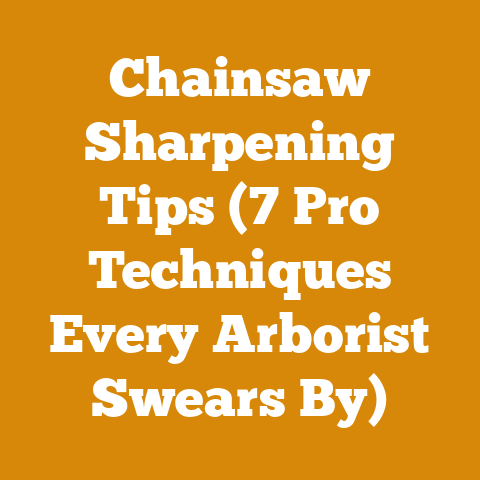Small Tree Roots Removal (5 Proven Arborist Techniques)
“I’ve got this old oak stump in my backyard, and the roots are everywhere!
I’ve tried digging, but it’s backbreaking work.
There’s gotta be a better way to get rid of these things without calling in a demolition crew,” one customer told me.
You’re right, there is!
Removing small tree roots can be a real pain, but with the right techniques and a bit of elbow grease, it’s a manageable task.
Over the years, I’ve dealt with countless root removal projects, from small backyard nuisances to larger forestry operations.
I’ve learned that there’s no one-size-fits-all solution, but there are proven methods that can make the job much easier.
Let’s dive into five effective techniques for small tree root removal, combining practical advice with my personal experiences and insights.
Small Tree Roots Removal (5 Proven Arborist Techniques)
1. Manual Excavation and Root Cutting: The Old-Fashioned Way
This is the most straightforward method, involving good old-fashioned digging and cutting.
While it requires some physical effort, it’s often the most practical approach for smaller roots and stumps.
Tools You’ll Need:
- Shovel: A sturdy shovel is essential for digging around the roots.
I prefer a pointed shovel for breaking through tough soil. - Pickaxe: For stubborn, rocky soil or larger roots, a pickaxe can be a lifesaver.
- Root Saw: A specialized saw designed for cutting roots.
These saws have aggressive teeth that can handle soil and debris. - Loppers or Pruning Shears: For smaller roots, loppers or pruning shears will do the trick.
- Chainsaw (Optional): For larger roots, a chainsaw can significantly speed up the process.
Safety is paramount when using a chainsaw near soil.
Ensure you are wearing appropriate safety gear (eye protection, ear protection, gloves, and chaps) and be extremely cautious to avoid hitting rocks or soil, which can damage the chain and cause kickback. - Gloves: Protect your hands from blisters and cuts.
- Eye Protection: Safety glasses or goggles are crucial to protect your eyes from flying debris.
The Process:
- Clear the Area: Start by clearing away any debris, rocks, or vegetation around the stump and roots.
This will give you a clear working space and reduce the risk of damaging your tools. - Excavate Around the Roots: Use the shovel and pickaxe to dig around the roots, exposing as much of them as possible.
The deeper you dig, the easier it will be to cut through the roots. - Cut the Roots: Once the roots are exposed, use the root saw, loppers, or chainsaw to cut them.
Start with the smaller roots and work your way up to the larger ones. - Remove the Stump and Roots: After all the roots are cut, you should be able to remove the stump and remaining roots.
You may need to use the pickaxe to loosen any stubborn roots. - Fill the Hole: Once the stump and roots are removed, fill the hole with soil and compact it.
My Personal Experience:
I remember one time I was helping a friend remove a stubborn oak stump from his yard.
We spent hours digging and cutting, and it felt like we were barely making progress.
Finally, I decided to bring out my trusty chainsaw.
With careful cuts, we were able to sever the larger roots and finally remove the stump.
It was a backbreaking day, but the satisfaction of seeing that stump gone was well worth the effort.
Key Considerations:
- Soil Type: The type of soil you’re working with can significantly impact the difficulty of the job.
Sandy soil is much easier to dig through than clay soil. - Root Size: The size of the roots will determine the tools you need and the amount of effort required.
- Safety: Always wear appropriate safety gear and be cautious when using power tools.
Takeaway:
Manual excavation is a reliable method for removing small tree roots, especially when dealing with smaller stumps and manageable root systems.
Be prepared for some physical exertion, and always prioritize safety.
2. Chemical Root Killers: A Patient Approach
Chemical root killers can be an effective way to eliminate tree roots, but they require patience and careful application.
These chemicals work by slowly killing the roots, causing them to decompose over time.
Types of Root Killers:
- Copper Sulfate: A common and relatively inexpensive root killer.
It’s effective but can be harmful to the environment if used improperly. - Potassium Nitrate: Another popular root killer, often sold in granular form.
It’s generally considered safer for the environment than copper sulfate. - Glyphosate: A broad-spectrum herbicide that can be used to kill roots.
However, it’s important to use it carefully to avoid harming surrounding plants.
Application Methods:
- Stump Application: Drill holes into the stump and pour the root killer into the holes.
This method is effective for killing the stump and preventing regrowth. - Soil Application: Dig around the roots and apply the root killer directly to the exposed roots.
This method is best for killing individual roots that are causing problems. - Sewer Line Application: Some root killers are specifically designed for use in sewer lines.
These products are formulated to kill roots without damaging the pipes.
The Process:
- Choose the Right Product: Select a root killer that is appropriate for your specific situation and follow the manufacturer’s instructions carefully.
- Prepare the Area: Clear away any debris or vegetation around the stump or roots.
- Apply the Root Killer: Apply the root killer according to the instructions on the product label.
Be sure to wear gloves and eye protection to avoid contact with the chemicals. - Wait for Results: It can take several weeks or even months for the root killer to completely kill the roots.
Be patient and monitor the area for any signs of regrowth.
My Personal Experience:
I once used a potassium nitrate root killer to eliminate a persistent willow stump in my backyard.
I drilled holes into the stump and poured the granules into the holes, following the instructions on the label.
It took several months for the stump to completely decompose, but eventually, it crumbled away, and I was able to fill the hole with soil.
Key Considerations:
- Environmental Impact: Be mindful of the environmental impact of the root killer you choose.
Some chemicals can be harmful to plants, animals, and water sources. - Safety: Always wear appropriate safety gear when handling root killers.
- Time: Chemical root killers can take a long time to work.
Be patient and don’t expect immediate results.
Takeaway:
Chemical root killers are a viable option for eliminating tree roots, but they require careful planning, application, and patience.
Always follow the manufacturer’s instructions and be mindful of the environmental impact.
3. Stump Grinding: A Professional Touch
Stump grinding is a more advanced technique that involves using a specialized machine to grind the stump and roots into small chips.
This method is particularly effective for larger stumps and roots that are difficult to remove manually.
What is a Stump Grinder?
A stump grinder is a powerful machine with a rotating cutting wheel that grinds away wood.
These machines come in various sizes, from small, portable models to large, self-propelled units.
The Process:
- Rent or Hire a Stump Grinder: You can rent a stump grinder from most tool rental companies, or you can hire a professional arborist to do the job for you.
I’d recommend hiring a professional if you are not familiar with the equipment. - Prepare the Area: Clear away any debris, rocks, or vegetation around the stump.
- Position the Stump Grinder: Position the stump grinder so that the cutting wheel is directly over the stump.
- Grind the Stump: Slowly move the cutting wheel back and forth across the stump, grinding it down to the desired depth.
- Grind the Roots: Once the stump is ground down, you can use the stump grinder to grind the surrounding roots.
- Fill the Hole: After the stump and roots are ground, fill the hole with soil and compact it.
My Personal Experience:
I once hired a professional arborist to grind a large oak stump in my yard.
The stump was too big and the roots too extensive for me to handle manually.
The arborist used a large, self-propelled stump grinder that made quick work of the stump and roots.
Within a few hours, the stump was gone, and I was able to fill the hole and replant the area.
Key Considerations:
- Cost: Stump grinding can be expensive, especially if you hire a professional.
- Safety: Stump grinders are powerful machines and can be dangerous if not used properly.
Always wear appropriate safety gear and follow the manufacturer’s instructions carefully. - Accessibility: Stump grinders can be difficult to maneuver in tight spaces.
Takeaway:
Stump grinding is an efficient way to remove large stumps and roots, but it requires specialized equipment and expertise.
Consider hiring a professional if you’re not comfortable operating a stump grinder yourself.
4. Root Pruning: Strategic Root Management
Root pruning involves selectively cutting roots to control tree growth or prevent damage to structures.
This technique is often used to manage roots that are encroaching on sidewalks, foundations, or utility lines.
When to Use Root Pruning:
- Preventing Damage: If tree roots are causing damage to sidewalks, foundations, or other structures, root pruning can help to alleviate the problem.
- Controlling Growth: Root pruning can be used to control the size and growth of a tree.
- Preparing for Transplanting: Root pruning can help to prepare a tree for transplanting by encouraging the growth of new, smaller roots.
The Process:
- Identify the Problem Roots: Carefully examine the area to identify the roots that are causing problems.
- Dig Around the Roots: Use a shovel to dig around the roots, exposing them.
- Cut the Roots: Use a root saw or loppers to cut the roots.
Make clean, angled cuts to promote healing. - Backfill the Hole: After the roots are cut, backfill the hole with soil and compact it.
- Monitor the Tree: Monitor the tree for any signs of stress or decline after root pruning.
My Personal Experience:
I once helped a neighbor prune the roots of a large maple tree that were causing cracks in his sidewalk.
We carefully dug around the roots and used a root saw to cut them back.
We made sure to make clean cuts and backfilled the hole with soil.
The sidewalk cracks stopped spreading, and the tree remained healthy.
Key Considerations:
- Timing: The best time to prune roots is during the dormant season (late fall or early spring).
- Severity: Avoid removing more than 25% of the tree’s roots at one time.
- Tree Health: Root pruning can stress a tree, so it’s important to ensure that the tree is healthy before pruning.
Takeaway:
Root pruning is a strategic approach to managing tree roots that can prevent damage and control growth.
It’s important to prune carefully and avoid removing too many roots at once.
5. Natural Decomposition: The Patient Gardener’s Choice
This method involves encouraging the natural decomposition of the stump and roots over time.
While it’s the slowest method, it’s also the most environmentally friendly and requires the least amount of effort.
How to Encourage Decomposition:
- Keep the Stump Moist: Moisture promotes decomposition, so keep the stump moist by watering it regularly.
- Apply Nitrogen Fertilizer: Nitrogen is an essential nutrient for decomposers, so applying a nitrogen fertilizer to the stump can speed up the process.
- Cover the Stump with Compost: Covering the stump with compost provides a source of organic matter and helps to retain moisture.
- Drill Holes in the Stump: Drilling holes in the stump creates more surface area for decomposers to work on.
The Process:
- Prepare the Stump: Cut the stump as close to the ground as possible.
- Drill Holes in the Stump: Drill several holes into the stump, spacing them a few inches apart.
- Apply Nitrogen Fertilizer: Apply a nitrogen fertilizer to the stump, following the instructions on the product label.
- Cover the Stump with Compost: Cover the stump with a layer of compost.
- Keep the Stump Moist: Water the stump regularly to keep it moist.
- Wait for Decomposition: It can take several years for the stump to completely decompose.
My Personal Experience:
I once used the natural decomposition method to eliminate a small pine stump in my backyard.
I cut the stump close to the ground, drilled holes in it, applied nitrogen fertilizer, and covered it with compost.
Over the course of several years, the stump slowly decomposed, and eventually, it disappeared completely.
Key Considerations:
- Time: Natural decomposition can take a long time, so be patient.
- Appearance: The decomposing stump may not be the most attractive sight in your yard.
- Pest Control: Decomposing wood can attract pests, so you may need to take measures to control them.
Takeaway:
Natural decomposition is a slow but environmentally friendly way to eliminate tree roots.
It requires minimal effort but can take several years to complete.
Conclusion: Choosing the Right Technique
Removing small tree roots can be a challenging task, but with the right techniques and tools, it’s a manageable project.
Whether you choose manual excavation, chemical root killers, stump grinding, root pruning, or natural decomposition, the key is to carefully assess your situation and choose the method that is best suited for your needs.
Remember to always prioritize safety and follow the manufacturer’s instructions when using power tools or chemicals.
With a little patience and effort, you can successfully remove those pesky tree roots and reclaim your yard.






